Apartment EV Charging: Strata-Friendly Solutions for Residents
Last Updated: 3rd Feb 2025 By Finn Peacock, Chartered Electrical Engineer
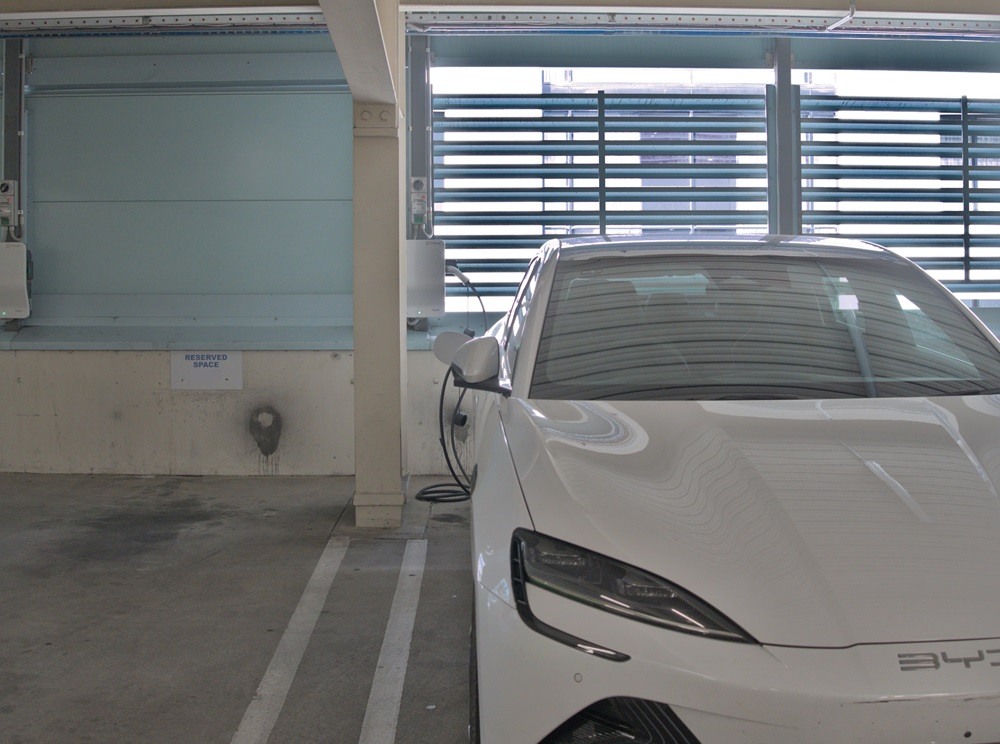
For EV owners living in an apartment building, charging can be tricky.
You could:
- Exclusively charge at public chargers (expensive).
- Charge using a trickle charger (if you have a standard outlet close enough to your parking space). This is painfully slow, and without Owners Corporation (OC) approval, could be considered stealing.
- Convince your OC to approve the installation of hard-wired Level 2 EV chargers.
This page provides a comprehensive guide to EV charging solutions for apartments and other strata buildings. We will discuss the arguments needed to get strata approval for installation, survey residents’ charging needs, different approaches, and the costs associated with them.
Table of Contents
- Arguments to Convince the Owner’s Corporation of EV Charger Installation
- What Are the EV Charging Needs of Our Residents?
- Is EV Charging Feasible in Our Building?
- Which Is The Right Approach in Our Building’s Situation?
- What EV Charging Speed Do We Want for Our Building?
- Billing Options
- Regulations to Consider
- Installers to Consider
- Conclusion
Arguments to Convince the Owner’s Corporation of EV Charger Installation
The main argument for installing EV chargers is this:
“Installing EV chargers ensures the apartment complex remains future-proof, meeting the inevitable demand from residents as EVs become the norm, rather than scrambling to retrofit an outdated car park later at far greater expense and inconvenience.“
Other benefits include:
- The property value increases.
- Rentals become more attractive to tenants.
- The chargers’ billing system can provide a revenue stream for the OC.
- You are genuinely helping accelerate the transition to all-electric transport.
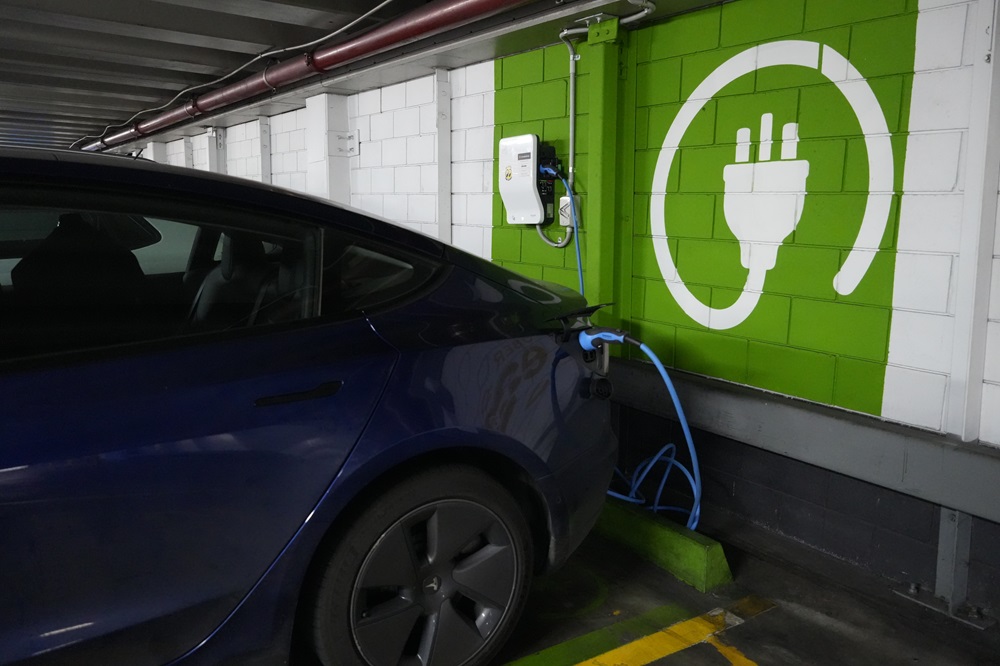
What Are the EV Charging Needs of Our Residents?
To establish residents’ charging needs, it’s a good idea to survey the owners and tenants of your building. The NSW government has an EV-ready resident survey template.
Next up, you will need to organise a feasibility assessment.
Is EV Charging Feasible in Our Building?
To prevent overload issues, it is important to know if the current electrical infrastructure can support the demand of a Level 2 charger. Find an energy auditor to investigate your building’s electrical capacity. Inform your strata committee about your intention to have the building audited. By involving them early, you increase your changes of getting their final approval for installation. The energy auditor will assess:
- existing circuit breaker sizes
- maximum capacity of the building
- historical peak energy loads
- historical off-peak energy loads
- energy usage patterns
- possible locations for additional distribution boards
- energy efficiency to reduce load and create extra electrical capacity (such as lighting upgrades)
- spare load capacity to accommodate EV chargers.
The energy auditor will also be able to provide information on:
- load control, including upgrading the electrical service as a last resort, to ensure sufficient electrical capacity for the site
- modifying the electrical panel to create circuits as required
- running cable to connect the charging supply equipment with the switchboard, sometimes on a different level to the electrical service
- options for including solar panels and battery storage
This assessment should determine whether your building is considered:
- EV-ready: the building has the infrastructure in place to support immediate EV charger installation in designated parking spaces.
- EV-capable: the building has adequate electrical capacity and suitable wiring but may require minor adjustments to become fully EV-ready. E.g.: distribution boards and wiring are in place, but not all parking spaces may have accessible outlets or circuits.
- Insufficient: the building’s infrastructure lacks the capacity or necessary wiring to support EV chargers without significant upgrades. E.g.: it requires substantial upgrades to transformers, wiring, or even grid connections.
Which Is The Right Approach in Our Building’s Situation?
Let’s have a look at some of the different approaches for different scenarios and what they might cost:
Approach #1: Individual Approach – No Existing EV Charging Infrastructure
- When to use this approach:
- Charging is owner’s responsibility
- No distribution box or meter near the car space
- How does it work?
- Charger is installed in individual lots.
- Owner installs and owns both the EV charging infrastructure and the charger.
- Price range estimates (including installation): $2,000 – $20,000, including EV charger
- Who pays? Owner
Approach #2: Individual Approach – Use Existing Circuits and Meter
- When to use this approach:
- Charging is owner’s responsibility
- Distribution box and meter are near the car space
- How does it work?
- Owner installs and owns the charger, using existing electrical circuits.
- Owner may need to pay for interlock switches to share existing circuits.
- Price range estimates (including installation): $2,000 – $10,000, including EV charger
- Who pays? Owner
Approach #3: Shared Common Property Car Spaces Approach
- When to use this approach:
- OC assigns common property car spaces for EV charging
- How does it work?
- Requires a scheduling system to manage resident use of the EV charging station.
- Price range estimates (including installation): $20,000 – $50,000, including EV charger
- Who pays? OC. May recover cost through access fee.
Approach #4: Modular Approach
- When to use this approach:
- OC wants a planned collective approach for EV charging that is developed in stages.
- How does it work?
- Chargers are located in individual lots.
- EV charging infrastructure consists of modular EV readiness box(es), each supporting charging for 6 EVs.
- Price range estimates (including installation): $5,000 – $7,000 per box for the EV charging infrastructure
$2,000 – $3,000 per connection, including EV charger - Who pays? OC. May recover cost over time from users. Owners pay for connection and EV charger.
Approach #5: Whole of Building Approach
- When to use this approach:
- OC wants to retrofit the building to be ready for all owners to have EVs.
- How does it work?
- Chargers are located in individual lots.
- EV charging infrastructure is installed to service at least one existing resident car space per apartment.
- Price range estimates (including installation): $75,000 – $200,000 per box for the EV charging infrastructure
$2,000 – $3,000 per connection, including EV charger - Who pays? OC. May recover cost over time from users. Owners pay for connection and EV charger.
Financial Planning Tips for Installing EV Charging in Multi-Residential Buildings
Installing EV charging infrastructure can be a substantial investment, especially for multi-residential buildings where costs must often be shared among owners. There are currently no rebates for multi-residential buildings. However, here are some financial planning tips to consider:
1. Develop a Detailed Cost-Benefit Analysis
Start with a clear analysis of upfront costs versus the long-term benefits. Consider factors like property value increases, potential rental income from EV owners, and whether the installation could make the building more attractive to prospective buyers or tenants.
2. Evaluate Funding Sources and Financing Options
While there are currently no grants specifically for EV charging in multi-residential buildings, owners might look into green loans or low-interest financing options through banks and energy providers. Some lenders offer loans specifically for energy-efficiency upgrades, which could cover EV charging infrastructure.
The Clean Energy Finance Corporation’s Household Energy Upgrade Fund works with several lenders, but eligibility varies.
3. Establish a Cost-Recovery Model
Design a payment structure for residents who use the chargers, allowing the OC to recoup installation and ongoing maintenance costs. Options include flat fees, usage-based billing, or a subscription model. Using smart billing systems can help track and allocate costs fairly among residents.
4. Budget for Ongoing Maintenance
Maintenance and software fees can add to the ongoing costs of EV chargers. Create a maintenance reserve fund for repairs, software subscriptions, and upgrades. This can prevent unexpected expenses and ensure the system remains functional and up-to-date.
By planning carefully and establishing cost-recovery measures, OCs can approach EV charging installation in a financially sustainable way that benefits both owners and residents.
What EV Charging Speed Do We Want for Our Building?
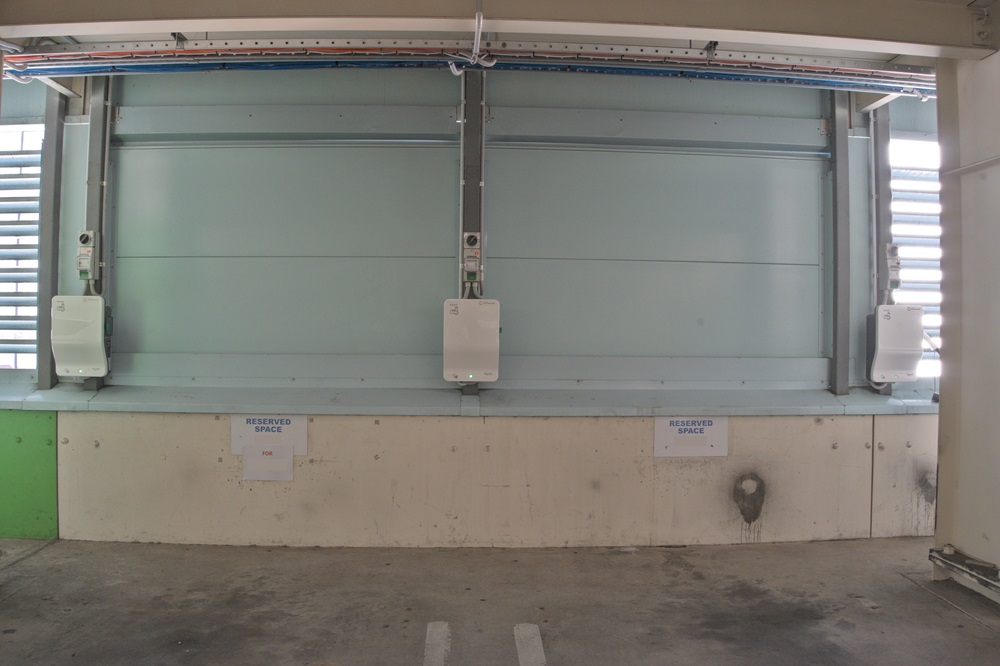
To understand the basics of EV charging speeds, read more about the difference between Level 1, 2, and 3 charging here. Now, let’s look at the different levels in the context of an apartment building.
Level 1 Charging: No infrastructure changes needed
If your car park has regular power outlets, then plugging your car in using its slow Level 1 trickle charger is already an option. However, most OCs would not enjoy having to foot the bill for other residents’ charging.
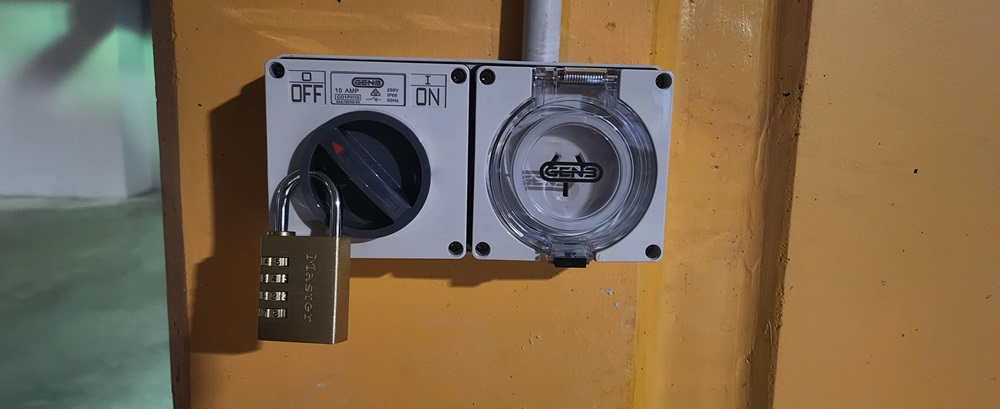
With something like Alchemy Charge’s SmartPoint, those regular 10 amp 240v outlets become more weather-proof and durable and connect to WiFi. This makes charging trackable, allowing property managers to bill each user separately. The installation is as straightforward as fitting a new power point, and at $399-$499 it makes them accessible for most properties, since it requires no major electrical upgrades.
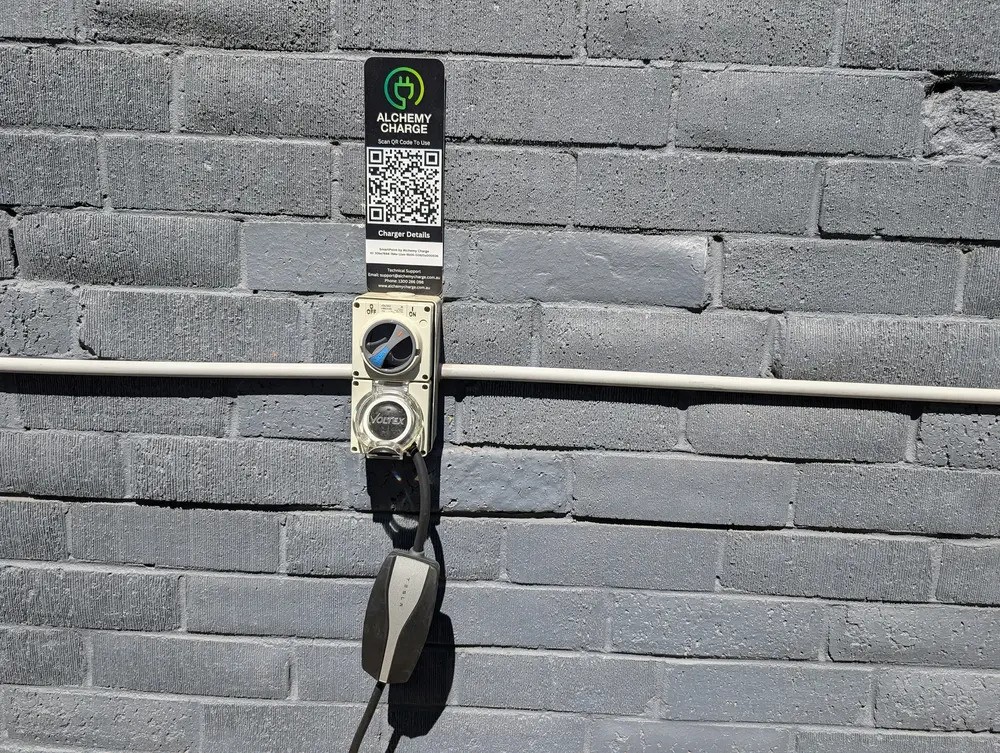
Level 2 Charging: infrastructure changes may be needed
For a hard-wired Level 2 EV charger that charges at rates to 7.4 kW, the feasibility assessment should show whether there’s enough available capacity to power Level 2 chargers without overloading the system.
A load management system is often recommended/required for EV charging in shared buildings. This system balances the electricity flow, adjusting charging rates during peak hours to prevent overloading.
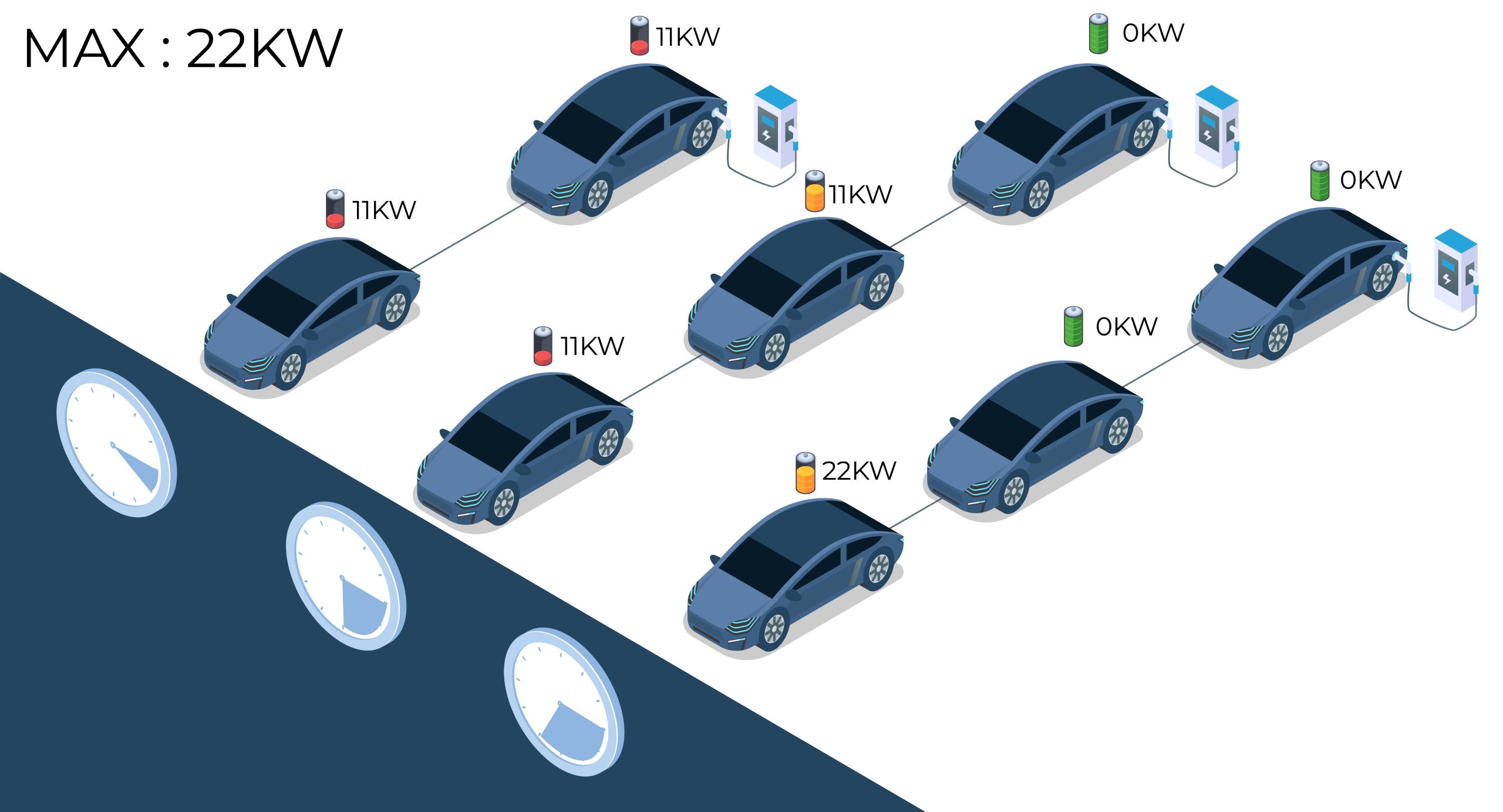
Load management systems also help:
- Optimise charging schedules: Chargers can be set to use full capacity during off-peak hours (such as late at night) when electricity rates are lower and demand is reduced.
- Prevent costly infrastructure upgrades: By balancing power needs across multiple chargers and reducing strain on the building’s electrical supply, load management systems can delay or eliminate the need for extensive electrical upgrades.
- Allocate power dynamically: As more residents adopt EVs, a load management system can distribute available power fairly among chargers, so all users have access to charging without overwhelming the system.
Level 3 Charging: impractical and expensive
A Level 3 DC fast charger that charges at rates of more than 22 kW could be possible, but it would likely require extensive upgrades to the building’s main switchboard, transformers, and wiring to handle the high power draw. This could involve reconfiguring switchboards, upgrading existing transformers, and running larger electrical cables, making it an impractical, expensive solution.
Billing Options
1) Dedicated Meters
- Description: A dedicated electrical meter can be installed for each EV charger, either linked directly to the user’s apartment meter or to a separate sub-meter for accurate tracking.
- Pros:
- ✅ Provides direct, precise billing based on actual usage.
- Cons:
- ❌ Installation may require extra wiring and electrical work, which can increase costs.
- Best suited for: Buildings where individual metering is feasible or where there’s a need to track usage at the individual charger level.
2) Prepaid / Subscription-Based Billing
- Description: Some buildings adopt a prepaid or subscription model, where EV owners pay a fixed monthly or prepaid fee for a set amount of electricity.
- Pros:
- ✅ Simplifies billing and reduces administrative work.
✅ Allows for a predictable monthly cost for EV users.
- ✅ Simplifies billing and reduces administrative work.
- Cons:
- ❌ May not be as precise for actual usage if EV owners’ needs vary.
❌ Some users may overpay or underpay relative to their usage.
- ❌ May not be as precise for actual usage if EV owners’ needs vary.
- Best suited for: Buildings with predictable EV charging needs, where precise billing isn’t critical, or where EV usage is light.
3) Load Management and Shared Billing
- Description: A load management system distributes power to multiple chargers and tracks individual usage, then allocates the electricity costs accordingly.
- Pros:
- ✅ Efficiently balances power across multiple users, preventing overload and sharing costs based on actual consumption.
- Cons:
- ❌ Requires a sophisticated load management and tracking system, which can be costly upfront.
- Best suited for: Large buildings with multiple EV chargers where fair distribution of power and costs is essential.
4) RFID or App-Based Billing Systems
- Description: Some smart chargers are equipped with RFID card readers or app-based systems. Users scan their card or log in to the app, which tracks their usage and bills them directly.
- Pros:
- ✅ Convenient and user-friendly.
✅ Accurate billing based on real-time usage.
✅ Users can also track their usage history and receive invoices automatically.
- ✅ Convenient and user-friendly.
- Cons:
- ❌ May require specific chargers and setup, with ongoing costs for software maintenance or transaction fees.
- Best suited for: Modern buildings or facilities with a high density of EV users who value convenience and individualised billing.
5) Common Property Charge with Reimbursement
- Description: The Owners Corporation (OC) covers the cost of EV charging, and EV owners reimburse the OC based on a flat rate or usage estimate.
- Pros:
- ✅ Straightforward for the OC and simplifies installation, as chargers are connected to common property power.
- Cons:
- ❌ May lead to disputes if reimbursement rates don’t match actual usage; can be complex for larger numbers of users.
- Best suited for: Smaller buildings or those with only a few EV users, where the costs are relatively low and easy to allocate.
6) Utility-Billed with Individual Accounts
- Description: Some buildings set up agreements with electricity providers that allow EV chargers to be billed directly to individual residents’ utility accounts.
- Pros:
- ✅ Simplifies billing, as the utility company handles it.
✅ Residents are billed directly for their own usage.
- ✅ Simplifies billing, as the utility company handles it.
- Cons:
- ❌ May not be possible in all regions or with all providers, and requires utility buy-in.
- Best suited for: Buildings with supportive utility companies that can accommodate individual billing for shared chargers.
7) Peer-to-Peer Billing Solutions
- Description: Emerging technologies allow for peer-to-peer (P2P) billing through platforms where residents with chargers share access and bill each other, often facilitated by blockchain or similar technologies.
- Pros:
- ✅ Encourages resource-sharing and community solutions with individualised billing.
- Cons:
- ❌ Limited by technology availability and adoption.
❌ May require additional oversight to manage disputes.
- ❌ Limited by technology availability and adoption.
- Best suited for: Innovative buildings or communities open to shared solutions and new technology adoption.
Billing Options Summary
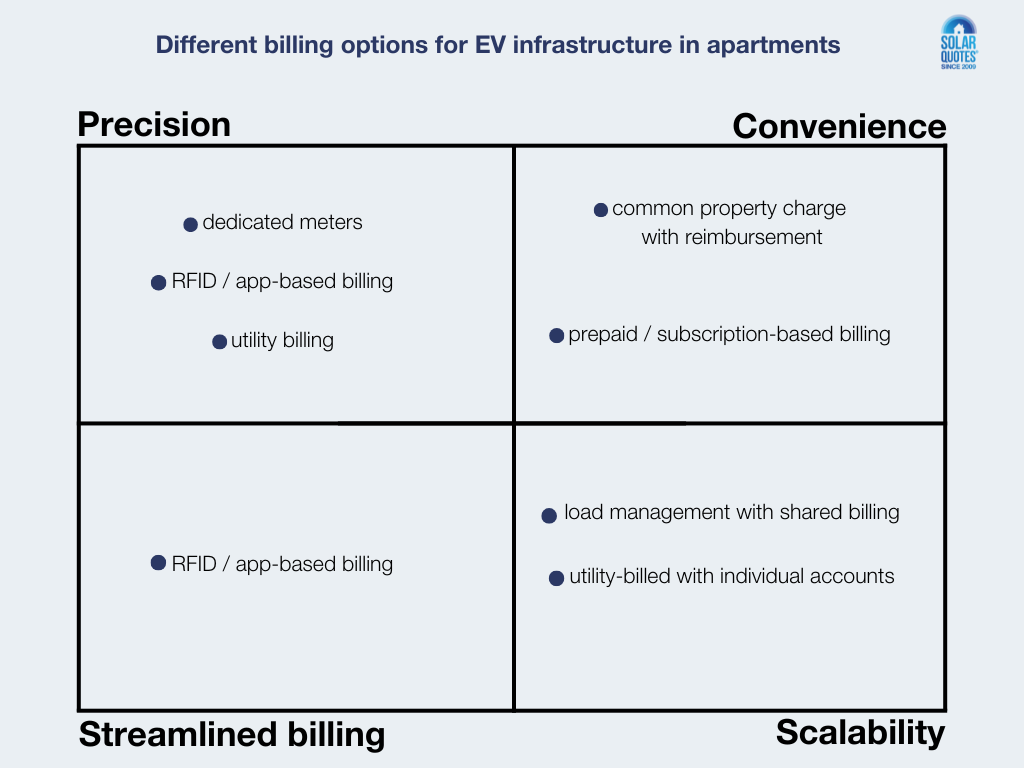
In summary, if you want:
- precision, go for dedicated meters, RFID / app-based billing, or utility billing.
- convenience, go for the common property charge with reimbursement or prepaid / subscription-based billing.
- scalability, go for load management with shared billing or utility-billed with individual accounts.
- streamlined billing, go for RFID / app-based billing
Regulations to Consider
Federal Regulations
The 2022 update to the National Construction Code (NCC) introduced new provisions to improve EV-readiness in apartment buildings. These changes mean that new multi-residential buildings with car parks must now include electrical infrastructure that can support the future installation of EV chargers for each parking space.
State Regulations
For a new building, state fire safety regulations require developer approval from local fire services. This process checks that the building is safe and won’t pose a fire risk. Fire officers look at different parts of the building to see if any materials, designs, or other features could increase the chance of fire.
While EVs are still less likely to catch fire than a regular ICE car, certain safety measures, such as E-stops or lithium fire blankets, should still be present near the chargers. Lithium fires are unique because they can reach extremely high temperatures and even reignite after extinguishment. Traditional fire-fighting methods, like water or CO2 extinguishers, are often ineffective or dangerous with lithium fires.
Strata By-laws
Strata legislation generally follows specific voting procedures for changes to common property (such as installing electric vehicle chargers in parking areas). States like NSW, ACT, and WA only require a simple majority of 50% to pass the motion. However, in QLD, SA, VIC, and TAS, you need a special resolution of at least 75%.
Installers to Consider
To find an installer, you can compare reviews on Google, ProductReview, or our own SolarQuotes installer reviews. To help your search, we listed an EV charger installer per state from our SQ network who services apartment buildings.
| State/Territory | Recommended Installer |
|---|---|
| New South Wales | Spark Innovation Group |
| Victoria | EOC Energy |
| Queensland | ReGen EV Charging Install |
| Western Australia | Solaire Connect |
| South Australia | EV Charge Australia |
| Northern Territory | Eco Tech Electrical |
| Tasmania | I Want Energy |
| Australian Capital Territory | LV Renewables |
Conclusion
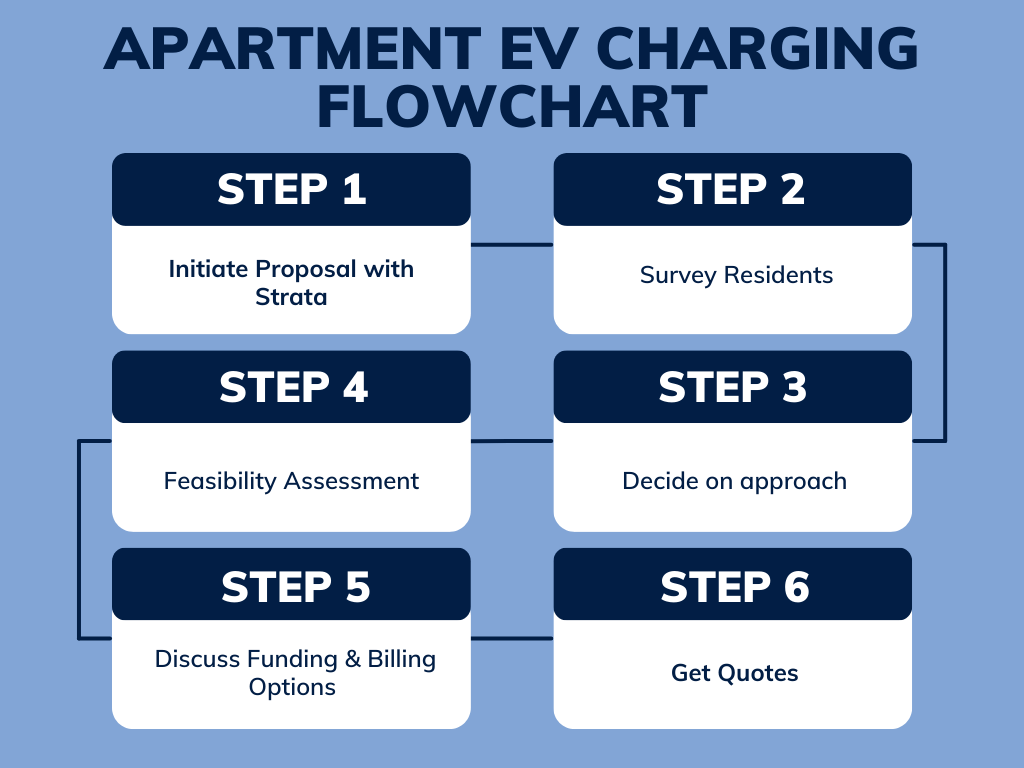
To summarise, your proposal should include:
- survey results detailing the residents’ EV charging needs
- the energy auditors’ feasibility report
- an approach that best suits your building’s needs
- a billing option that best suits this approach
- a plan that stipulates who pays for what and potential funding options
- quotes from certified installers
With a detailed proposal, you are best prepared to convince the OC to allow the installation of apartment EV charging solutions.
If you’re ready to start, SolarQuotes can connect you with experienced installers and help guide you through the process with trusted advice tailored to strata requirements.